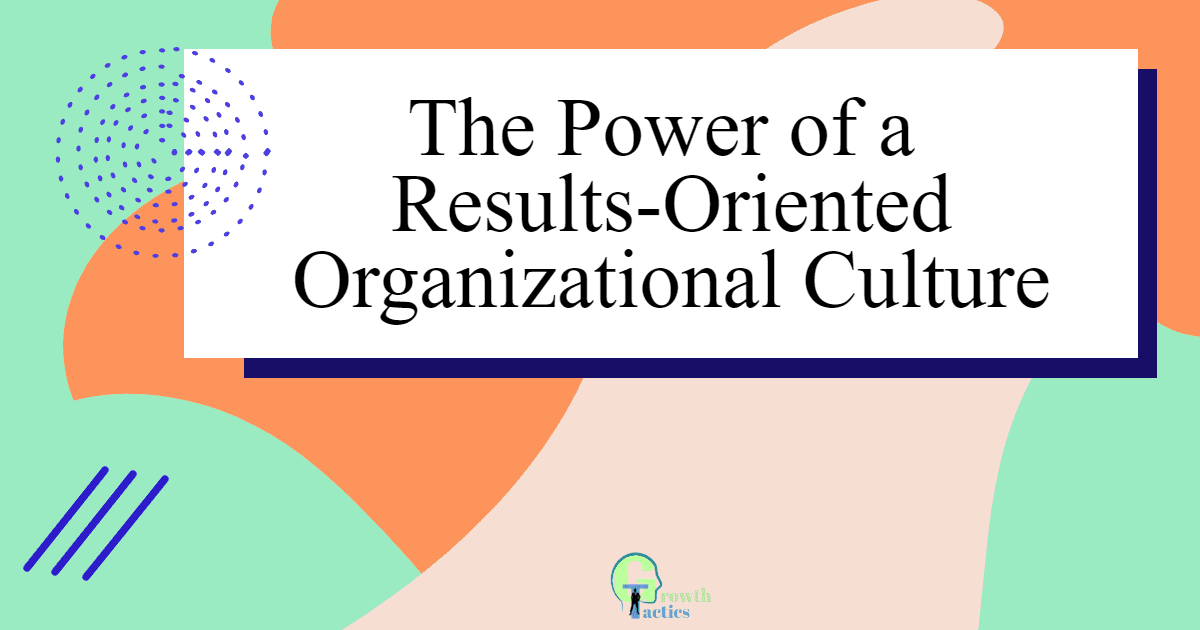A results-oriented organizational culture is a culture that emphasizes achieving desired outcomes and delivering results. When a company cultivates a results-driven work environment, it can boost productivity, increase employee engagement, and drive success. Developing a results-oriented culture is crucial for achieving long-term success in today’s competitive market.
Jump To Section
Understanding the Benefits of a Results-Oriented Culture
A results-oriented culture within an organization can bring numerous benefits that contribute to its overall success. By shifting the focus from activities to outcomes, companies can achieve higher productivity, improved employee engagement, and more effective decision-making. Let’s explore these benefits in more detail:
Increased Productivity and Efficiency
A results-oriented culture emphasizes the importance of getting things done efficiently and effectively. By setting clear expectations and goals, employees are empowered with a sense of purpose and direction. This clarity enables them to prioritize tasks, eliminate distractions, and focus on activities that directly contribute to the desired results. As a result, productivity levels are heightened, and the organization can accomplish more in less time.
Improved Employee Engagement and Morale
A results-oriented culture instills a sense of ownership and accountability among employees. When individuals understand that their contributions directly impact organizational outcomes, they become more engaged and motivated to perform at their best. This increased engagement leads to higher job satisfaction and morale, creating a positive work environment where employees feel valued and empowered.
Enhanced Decision-Making and Problem-Solving Capabilities
A results-oriented culture promotes a mindset focused on finding solutions and achieving desired outcomes. This mindset encourages employees to think critically and creatively when faced with challenges or obstacles. With a results-driven approach, decisions are made based on the potential impact on achieving desired results. This leads to more effective problem-solving, as individuals are motivated to find innovative solutions that contribute to the organization’s success.
By understanding and embracing these benefits, organizations can develop a results-oriented culture that drives performance and achieves long-term success.
Creating a Results-Oriented Organizational Culture
While recognizing the benefits of a results-oriented culture is essential, actually creating one can be challenging. Cultivating a culture that embodies a results-driven approach requires commitment and effort from leaders and employees alike. Here are some steps that organizations can take to develop a results-oriented organizational culture:
- Define clear goals and expectations. Start by setting clear and measurable goals that align with the organization’s mission and vision. Ensure that every employee understands these goals and the role they play in achieving them.
- Provide the necessary resources and support. Ensure that employees have the resources and support they need to accomplish their goals. This can include access to technology, training, and tools.
- Promote accountability. Foster a culture of accountability by holding individuals and teams responsible for achieving their goals. This means recognizing and rewarding those who deliver results while addressing underperformance.
- Measure progress and celebrate successes. Monitor progress and regularly communicate updates on how the organization is performing against its goals. Celebrate successes along the way to build momentum and maintain motivation.
- Lead by example. Leaders should lead by example and embody a results-driven approach in their own work. This means setting clear expectations, modeling effective decision-making, and holding themselves accountable for delivering results.
- Encourage innovation and risk-taking. Foster an environment that encourages innovation and risk-taking, where employees feel empowered to propose and implement new ideas that can contribute to organizational success.
- Regularly evaluate and adapt. Regularly evaluate progress and adjust strategies and tactics to ensure that the organization remains on track to achieve its goals.
Overall, developing a results-oriented culture requires a shift in mindset and culture that begins with leadership. By clearly defining goals, promoting accountability, and measuring progress, organizations can create a culture that is driven by results and ultimately achieves success.
Key Strategies for Building a Results-Oriented Culture
Building a results-oriented culture isn’t easy, but there are some key strategies that organizations can follow to develop a culture that emphasizes achieving desired outcomes and delivering results. Here are the top strategies to consider:
1. Clarify Goals and Objectives
Defining clear goals and objectives is the first step in creating a results-oriented culture. Leaders should communicate these objectives and ensure every team member understands what they need to do to achieve them. The goals should be specific, measurable, and relevant to the organization’s overall mission and vision.
2. Foster Accountability
Accountability is crucial for a results-oriented culture. Employees should understand their role in achieving organizational goals and be held responsible for their performance. Leaders should establish a system for tracking progress, identify any performance gaps, and provide the necessary support to help employees achieve their objectives.
3. Provide Continuous Feedback and Improvement Opportunities
Continuous feedback is essential for building a results-oriented culture. Leaders should provide regular feedback to employees on their performance and progress towards goals, as well as identify opportunities for improvement. Employees should be encouraged to identify areas for improvement and suggest new ways of working.
4. Encourage Employee Collaboration
Collaboration between teams and individuals can help generate new ideas, identify opportunities, and drive performance. Leaders should encourage collaboration by establishing cross-functional teams, using technology to facilitate communication, and promoting a culture of transparency and openness.
5. Recognize and Reward Success
Recognizing and rewarding employees for their contributions is critical for building a results-oriented culture. Leaders should identify ways to recognize employees who contribute to the attainment of organizational goals, encourage positive work behavior and good performance, and establish reward schemes that align with the results achieved.
By following these key strategies, organizations can build a culture that is results-driven and thrives on delivering outcomes that contribute to long-term success.
Overcoming Challenges in Implementing a Results-Oriented Culture
Implementing a results-oriented culture is essential for any organization that wants to achieve success. It involves shifting the organizational mindset from focusing on processes and activities to focusing on outcomes and results. However, transitioning to a results-oriented culture is not an easy task. It requires a lot of effort, time, and dedication from everyone in the organization. In this article, we will discuss the challenges you may face in implementing a results-oriented culture and how to overcome them.
Challenge 1 – Resistance to Change
One of the biggest challenges organizations face when transitioning to a results-oriented culture is resistance to change. People generally resist change because they are comfortable with the current workflow, culture, and mindset. To overcome this challenge, the organization’s leaders need to communicate why this change is necessary and what the benefits are. Educate employees on how a results-oriented culture will improve the organization, its productivity, and how it will benefit them in the long run.
Challenge 2 – Lack of Accountability
For a results-oriented culture to thrive, everyone in the organization needs to take responsibility for their actions. Lack of accountability can hinder the success of this culture, as it entails that everyone works towards a common goal. To tackle this challenge, leaders should set clear expectations and goals, establish performance metrics, and track results. This practice creates a sense of ownership, which will hold everyone accountable for their performance.
Challenge 3 – Insufficient Data Infrastructure
Data is vital in a results-oriented culture, it helps in making informed decisions based on objective evidence rather than subjective input. Without adequate data infrastructures, an organization may find it challenging to track progress and performance, which affects the ability to make informed decisions. In overcoming this challenge, leaders must invest in technology that supports data collection, analysis, and reporting.
Challenge 4 – Ineffective Reward System
Rewards are effective tools for motivating employees towards achieving their goals and objectives. However, using the wrong reward system may encourage suboptimal behavior, disorientation, and lack of collaboration. To overcome this challenge, leaders should create a reward system that aligns with the desired organizational culture and goals. Offer incentives that encourage team collaboration, innovative thinking, and problem-solving.
Challenge 5 – Misaligned Priorities
Organizations with a wide variety of goals and objectives may find it hard to align around the same priorities in a results-oriented culture. Different teams or departments often have individual targets, making it challenging to create a unified approach. To overcome this hurdle, leaders should create a shared vision outlining objectives, metrics, and decisions that reflect the particular organizational cultures.
Case Studies of Successful Results-Oriented Cultures
Looking at real-world examples of organizations that have successfully implemented a results-oriented culture can provide valuable insights and inspiration. Let’s explore a few case studies of organizations that have excelled in fostering a results-driven environment:
Example 1: Google
Google is known for its highly results-oriented culture, which emphasizes innovation and continuous improvement. They provide employees with clear goals and objectives, allowing them the freedom to explore creative solutions. Google also supports a culture of collaboration, enabling employees to work across teams and share ideas. The company measures success by analyzing data and using metrics to evaluate progress towards goals. Regular feedback and recognition encourage employees to strive for excellence.
Example 2: Netflix
Netflix has built a results-oriented culture by fostering a high level of accountability and trust. They provide employees with clear expectations and the autonomy to make decisions to achieve results. Netflix measures performance against clearly defined objectives and values employees who demonstrate a focus on outcomes. They prioritize candid and open feedback, which plays a significant role in driving continuous improvement. Netflix also promotes a culture of learning and growth, encouraging employees to take calculated risks and learn from both successes and failures.
Example 3: Amazon
Amazon is well-known for its strong results-oriented culture, driven by its leadership principles. They set aggressive goals and relentlessly measure progress against them. Employees are encouraged to think big, take ownership, and innovate. Amazon values a data-driven approach, using analytics to guide decision-making and improve performance. They emphasize customer obsession and constantly seek ways to improve customer experience. Through a combination of high expectations, measurement, and a focus on customer outcomes, Amazon has created a successful results-oriented culture.
These case studies illustrate the importance of clear goals, accountability, continuous feedback, and a focus on outcomes in creating a results-oriented culture. Each organization has its own unique approach, but they all share the common thread of prioritizing and measuring results to drive success.
By studying these successful examples, organizations can gain valuable insights and best practices for building their own results-oriented culture, ultimately leading to improved performance, innovation, and long-term success.
Conclusion: Building a Results-Oriented Culture for Long-Term Success
Building a results-oriented culture within an organization takes time, effort, and commitment from leaders and employees. By setting clear goals, fostering accountability, providing continuous feedback, encouraging collaboration, and recognizing success, it is possible to create a culture that values achieving outcomes and delivering results.
By prioritizing results and focusing on outcomes, organizations can build a culture that is successful, sustainable, and engaging for employees. It is crucial for companies to adopt practical strategies and best practices from real-world examples to cultivate a results-oriented culture in the pursuit of long-term success.








